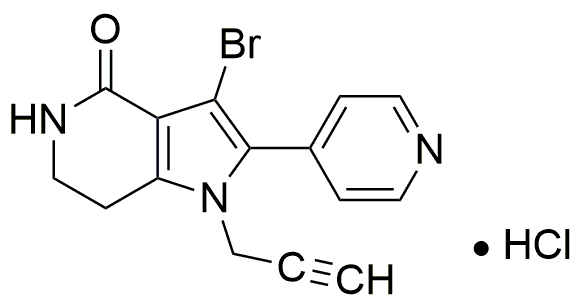AMI-331 hydrochloride is widely utilized in research focused on:
- Pharmaceutical Development: This compound is often used in the synthesis of new drug candidates, particularly in the development of treatments for various diseases, including cancer and autoimmune disorders.
- Biochemical Research: Researchers employ AMI-331 hydrochloride to study its effects on cellular processes, helping to uncover mechanisms of action that can lead to innovative therapeutic strategies.
- Analytical Chemistry: It serves as a standard reference material in analytical methods, aiding in the calibration of instruments and ensuring the accuracy of experimental results.
- Formulation Science: The compound is used in the formulation of various pharmaceutical products, enhancing stability and bioavailability, which are crucial for effective drug delivery.
- Clinical Trials: AMI-331 hydrochloride is often involved in clinical studies to evaluate its safety and efficacy, providing valuable data that can support regulatory approvals and market entry.
General Information
Properties
Safety and Regulations
Applications
AMI-331 hydrochloride is widely utilized in research focused on:
- Pharmaceutical Development: This compound is often used in the synthesis of new drug candidates, particularly in the development of treatments for various diseases, including cancer and autoimmune disorders.
- Biochemical Research: Researchers employ AMI-331 hydrochloride to study its effects on cellular processes, helping to uncover mechanisms of action that can lead to innovative therapeutic strategies.
- Analytical Chemistry: It serves as a standard reference material in analytical methods, aiding in the calibration of instruments and ensuring the accuracy of experimental results.
- Formulation Science: The compound is used in the formulation of various pharmaceutical products, enhancing stability and bioavailability, which are crucial for effective drug delivery.
- Clinical Trials: AMI-331 hydrochloride is often involved in clinical studies to evaluate its safety and efficacy, providing valuable data that can support regulatory approvals and market entry.
Documents
Safety Data Sheets (SDS)
The SDS provides comprehensive safety information on handling, storage, and disposal of the product.
Product Specification (PS)
The PS provides a comprehensive breakdown of the product’s properties, including chemical composition, physical state, purity, and storage requirements. It also details acceptable quality ranges and the product's intended applications.
Certificates of Analysis (COA)
Search for Certificates of Analysis (COA) by entering the products Lot Number. Lot and Batch Numbers can be found on a product’s label following the words ‘Lot’ or ‘Batch’.
*Catalog Number
*Lot Number
Certificates Of Origin (COO)
This COO confirms the country where the product was manufactured, and also details the materials and components used in it and whether it is derived from natural, synthetic, or other specific sources. This certificate may be required for customs, trade, and regulatory compliance.
*Catalog Number
*Lot Number
Safety Data Sheets (SDS)
The SDS provides comprehensive safety information on handling, storage, and disposal of the product.
DownloadProduct Specification (PS)
The PS provides a comprehensive breakdown of the product’s properties, including chemical composition, physical state, purity, and storage requirements. It also details acceptable quality ranges and the product's intended applications.
DownloadCertificates of Analysis (COA)
Search for Certificates of Analysis (COA) by entering the products Lot Number. Lot and Batch Numbers can be found on a product’s label following the words ‘Lot’ or ‘Batch’.
*Catalog Number
*Lot Number
Certificates Of Origin (COO)
This COO confirms the country where the product was manufactured, and also details the materials and components used in it and whether it is derived from natural, synthetic, or other specific sources. This certificate may be required for customs, trade, and regulatory compliance.


